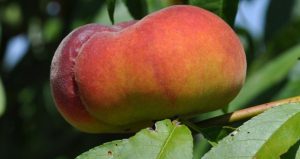I’m a native of Georgia, growing up just south of the region known as “peach country”. To me, there’s nothing better than a ripe, juicy peach on a summer day. I thought I had seen it at all when it came to peaches. That changed on a trip to the southwest U.S.
A few years ago, I was fortunate to make the voyage to Utah for the National Association of County Agricultural Agents annual meeting. A small group of county agents also participated in a pre-tour of the southwest region of Utah. This is where I found a treasure in the desert, as a host extension agent shared some of his oddly shaped, Saturn peaches from a nearby orchard.
The Saturn peach is a favorite in Utah and a favorite for hundreds of years in Asia. This is an asymmetrically shaped peach, with white, firm flesh. Some refer to this as a “donut peach”. It is an interesting fruit, that I must admit was one of the most delicious peaches that I’ve ever eaten.
Figure 1. “UFO” Peach.
Credit: Ali Sarkhosh, Mercy Olmstead, Jose Chaparro, Pete Andersen and Jeff Williamson. UF/IFAS Extension
I began to ponder why this peach variety was one that I had never encountered? After consulting with extension agents in neighboring southeastern states, I found that many universities had experimented with the variety. However, pitfalls in climate acclimation, mechanical harvesting (because the fruit is not round, harvesting equipment can damage) and marketing were discouraging. From a large commercial production interest, even if a viable yield could be grown in the region and custom designed harvesters were feasible, hurdles would still remain regarding the difficulty of marketing an introduced variety that has an unfamiliar and imperfect shape, versus well established varieties that can be graded as select. However, a healthy market may exist for small farms as novelty crop.
Furthermore, in 2002 UF/IFAS researchers breed and patented a similar variety of the Saturn peach that thrives anywhere in Florida. The Australia saucer peach was used to breed this new variety, known as the flying saucer or “UFO”. This peach has non-melting flesh with that unique donut shape, not unlike the Saturn. These trees are large and vigorous growing, with a semi-upright growth habit. The UFO produces moderately heavy crop loads of large, firm fruit with yellow flesh and semi-freestone pits that has a fruit development period of 95 days. As seen in figure 1, the skin develops 50–70% blush. This cultivar is particularly susceptible to ethylene that is released during dormant pruning, which can result in significant flower bud abortion. Thus, pruning is only recommended during the summer period.
Where do I find such a tree? Growers can purchase from nurseries who are licensed by the University to grow patented varieties. What about homeowners? Check your local garden centers. Now is great time to plant.
For more information please contact your local extension office.
Supporting information for this article obtained through past interviews of Dr. Wayne Sherman, Professor Emeritus, Department of Horticultural Sciences, UF/IFAS as well as from the following the UF/IFAS EDIS publication: “Florida Peach and Nectarine Varieties” by Ali Sarkhosh, Mercy Olmstead, Jose Chaparro, Pete Andersen and Jeff Williamson: https://edis.ifas.ufl.edu/pdffiles/MG/MG37400.pdf
UF/IFAS Extension is an Equal Opportunity Institution.
- Why Are Sand Dunes & Sea Oats So Important? - March 20, 2025
- How to Care for a Gift Plant - December 5, 2024
- Fall Leaf Colors Are Just Around the Corner - September 4, 2024

